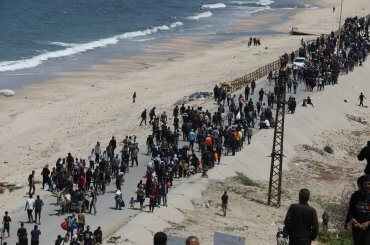Today’s long look at the Israeli Jewish colonies in occupied West Bank Palestine, complete with huge photos and detailed maps, has room for quotations from 11 different people, ranging from Benjamin Netanyahu to Nitza Farkash, an employee at the Eli settlement.
But not one Palestinian is asked for his or her reaction. Not one.
The reporters, Jodi Rudoren and Jeremy Ashkenas, did at least briefly notice the people who live under Israeli military occupation and whose land is being seized. One solitary sentence said that “. . . a Palestinian man grazed a few cows and sheep on a grassy hillside, and scores of teenagers in white Islamic head scarfs walked home from school.” But the reporters did not stop to ask them any questions.
(This short description is a masterpiece of Orientalist haiku. The Palestinians are only backward shepherds and young women in “Islamic head scarfs,” contrasted with the nearby “boomtown” Jewish settlement.)
There is more. We learn that back during Netanyahu’s first term as prime minister he “irked Washington in 1997 by adding 300 homes in Efrat.” He probably did more than “irk” the Palestinians who lost their land, but we won’t learn it from this article.
Our reporters did find that the settlements might cause human problems in the future. They warn that a peace agreement might eventually pose “the challenge of someday uprooting Israelis, who are now raising a second and third generation in contested areas.” But somehow, the two Times reporters could not find any Palestinians who are being uprooted today.



Typical. And this conspiracy by our media to keep Palestinians invisible and out of the conversation might help explain why young Zionists at U.S. universities claim to feel so “unsafe” and get so terrified and triggered when their real live Palestinian peers speak openly on campus. The media protects US Zionists from Palestinian viewpoints. So when young Zionists suddenly encounter in real life the people and ideas that have been hidden from them, they’re unnerved and feel “unsafe.”
This is Jim Crow journalism. Let’s not call it by another name, but for what it is.
NYT: isolated settlements, which are outside anyone’s conception of blocks, Map and wording keeps repeating that these are “isolated”, “insular” groups of houses.
Modiin Illit, an insular … enclave … that is widely expected to stay in Israel. Duh. Of course, if you don’t speak with Palestinians.
NYT: the Etzion block, stretching south from Jerusalem along Route 60. There were Jewish communities there before Israel’s establishment in 1948, … “it must be part of Israel for eternity.”
Brooklyn, this is your future.
I couldn’t finish the article, James. I feel dirty after plunging in. The massive photos on a biblical scale are front- paged as if it’s the most important story of this century! You are exactly right, of course, about the “masterpiece of Orientalist haiku.”. But this behemoth of propaganda leaves out the true people of the land~ all of them.
They disappeared the Palestinians. Then again, that is Israel’s plan and they are always working away at it~ every minute of every day for decades now.
And the NYT dutifully does its not insignificant part for Israel first, always, and only.